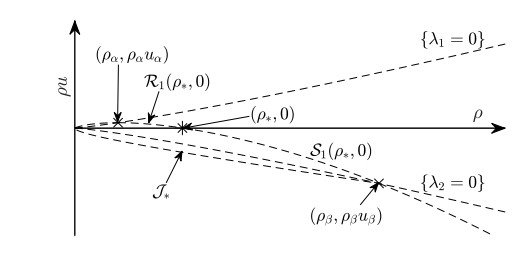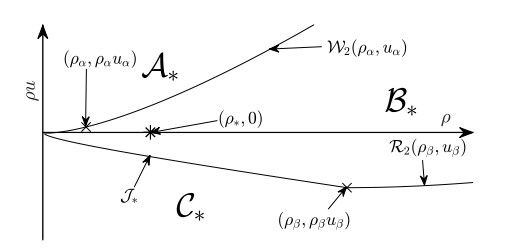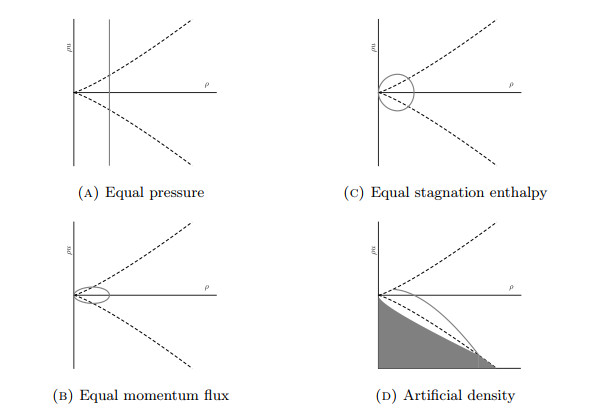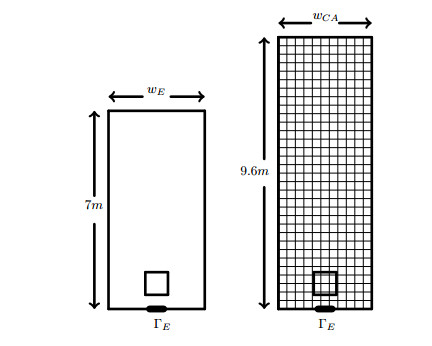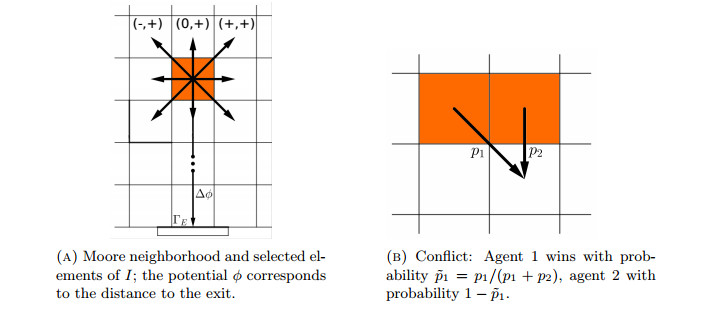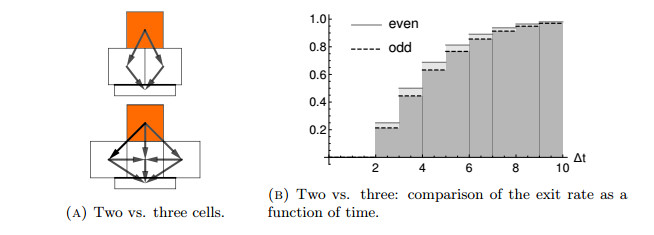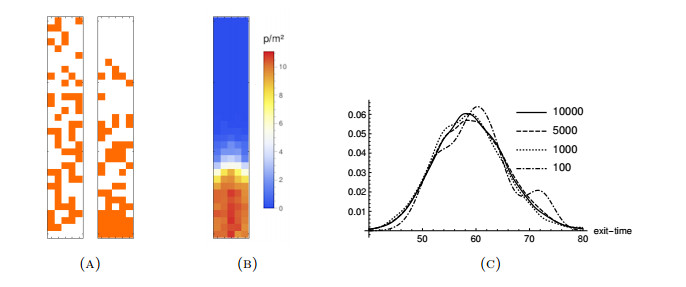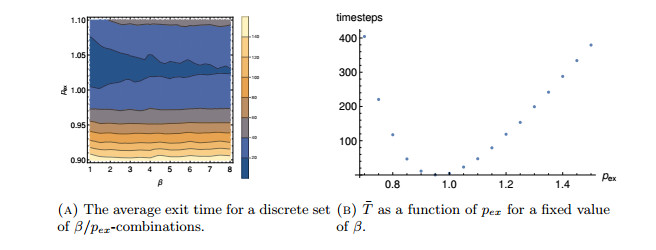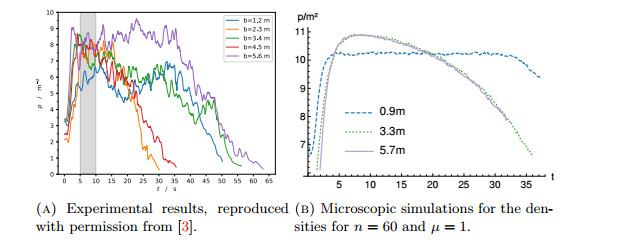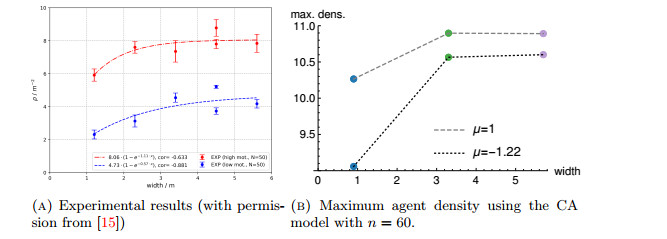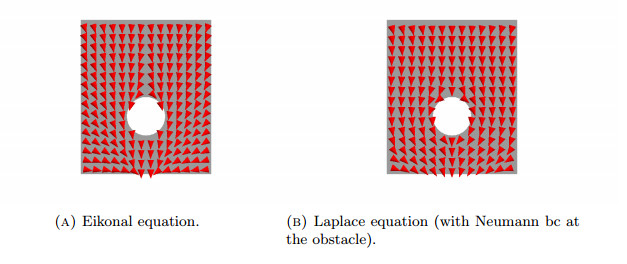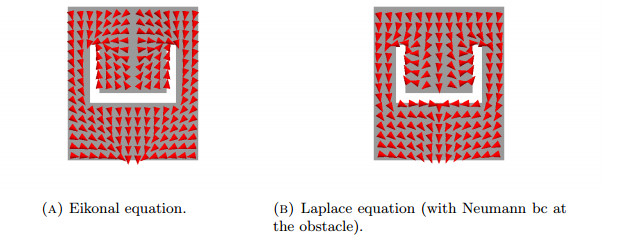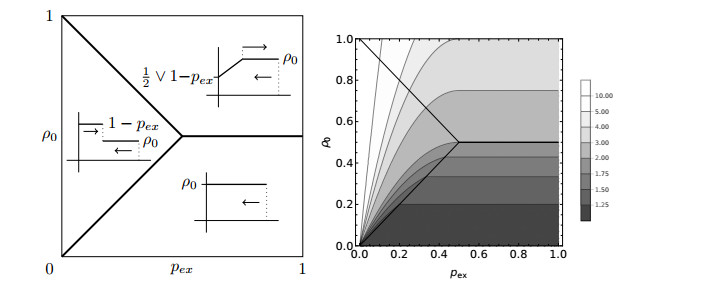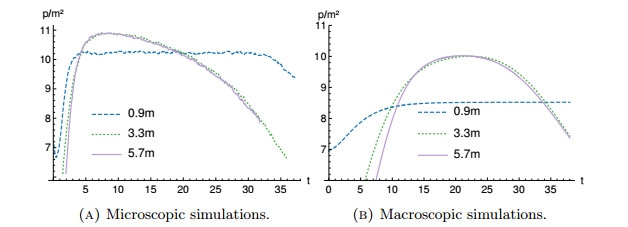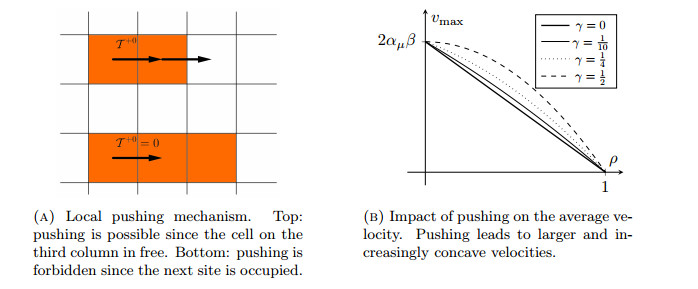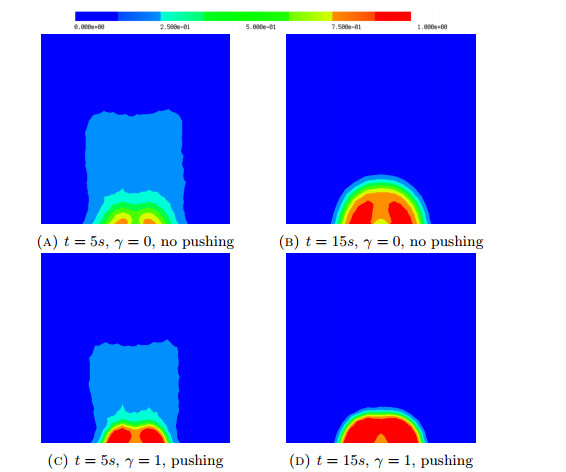1.
Introduction
We consider networks modeled by a directed graph where the dynamics on each edge are described by one-dimensional conservation laws. The dynamics are coupled at the vertices of the graph, called junctions. We are especially interested in (isentropic) gas dynamics, but there are many other applications for example in traffic, supply chains, data networks or blood circulation. This field became of interest to many researchers in the last two decades, see for example the overview by Bressan et al. [8]. A main challenge is posed by prescribing suitable coupling conditions at the junction. We consider novel conditions for the system of isentropic gas, also referred to as p-system.
The isentropic gas equations at a junction with k=1,…,d∈N adjacent pipelines are given by
where ρk≥0 denotes the gas density, uk∈R the mean velocity, and p=κργ the pressure given by the γ-pressure law with κ>0 and 1<γ<3. The equation is supplemented by an entropy condition, an initial condition (ˆρk,ˆuk)(x)=(ρk,uk)(0+,x), x>0 and a suitable coupling condition on the traces (ˉρk,ˉuk)(t)=(ρk,uk)(t,0+), t>0. Furthermore, we are interested in weak solutions to (1.1). For a general introduction to the theory of conservation laws see the book by Dafermos [17].
1.1. Previous results
The most challenging problem in modeling (gas) networks is to find physically correct coupling conditions. A first condition is usually conservation of mass at the junction
where Ak>0 denotes the cross-sectional area of the k-th pipeline. To ensure uniqueness of solutions, we impose more conditions at the junction. The number of additional conditions depends on the sign of the characteristic speeds at the junction. Several coupling conditions have been proposed, for example equality of pressure [1,2]
equality of momentum flux [10,11]
and equality of stagnation enthalpy/Bernoulli invariant [28]
Notice that the first two conditions are non-physically in the sense that energy may be produced at the junction [28]. Equality of stagnation enthalpy implies conservation of energy at the junction. We derive a coupling condition with dissipated energy at the junction. This is consistent with the isentropic gas equations where energy is also dissipated. The special situation with only two pipelines were studied in [13,21]
Usually existence and uniqueness of solutions to a generalization of the Riemann problem at the junction are studied locally in state space first. Reigstad [27] introduced a method to study existence and uniqueness almost globally in the subsonic region under a technical assumption. The results for the Riemann problem are used, to construct approximate solutions to the generalized Cauchy problem, usually by wave front tracking. See the book by Bressan [7] for a general introduction to the wave front tracking method. Colombo, Herty and Sachers [12] proved a general existence and uniqueness theorem for the generalized Cauchy problem by using this method. This theorem requires a transversality condition, subsonic data and sufficiently small total variation of the initial data.
Another approach to prove existence of solutions is the method of compensated compactness. This has been applied to a scalar traffic model [9] and the isentropic gas equations [22]. The method requires less assumptions on the regularity of the initial data but is restricted to systems with a large class of entropies. Moreover, less regularity of the solutions is obtained and the traces at the junction have to be considered carefully, see e.g. [5,22].
1.2. A new coupling condition
To supplement conservation of mass (1.2), we use an approach based on the kinetic model for isentropic gas and a maximum energy/entropy dissipation principle at the junction.
A kinetic model for the isentropic gas equations was introduced by Lions, Perthame and Tadmor [25]. The corresponding vector-valued BGK model were introduced by Bouchut [6]. For f=f(t,x,ξ) we impose
with Maxwellian M[f] (will be defined later). The half-space solutions are coupled at the junction by a kinetic coupling condition
To select the function Ψ, we follow an idea of Dafermos [16] and use maximum entropy/energy dissipation as a selection criteria for the physically correct kinetic coupling condition. More precisely, we determine Ψk such that as much energy is dissipated as possible under the condition of conserved mass. We obtain that for every pipeline the outgoing data is given by a Maxwellian with an artificial density ρϵ∗ and zero speed, i.e.
A formal limit argument leads to the definition of a generalized Riemann problem for (ρk,uk). As in [20], each half-space solution is given by the restriction of the solution to a standard Riemann problem. The left Riemann initial state is given again by an artificial state with a suitable density and zero speed.
Definition 1. Let (ˆρk,ˆuk)∈D, k=1,…,d. Then, we call (ρk,uk):(0,∞)t×(0,∞)x→D a weak solution to the generalized Riemann problem if the following assertions hold true:
RP0: The solution satisfies the constant initial condition
RP1: There exists ρ∗≥0 such that (ρk,uk) is equal to the restriction to x>0 of the weak entropy solution in the sense of Lax with initial condition
for all k=1,…,d.
RP2: Mass is conserved at the junction
where (ˉρk,ˉuk)=(ρk,uk)(t,0+)∈D, for a.e. t>0, k=1,…,d.
The set D is the state space and will be defined in Section 2. Notice that the condition RP1 can be reformulated using a Riemann problem formulation for boundary conditions V(ρ∗,0). This formulation was used by Dubois and LeFloch [18] and will be defined later. It is illustrated in Figure 3. The set V(ρ∗,0) will be used to define solutions to the generalized Cauchy problem (see Definition 6).
Since the new coupling condition is based on restrictions of standard Riemann problems, we get a simple wave structure for the solutions in the sense of Definition 1. This structure allows us to prove existence and uniqueness of solutions globally in state space. We can use techniques by Reigstad [27] in the subsonic regime and extend them to the full state space. A general local existence and uniqueness result [12] for the Cauchy problem applies to the new condition. As a by-product we obtain Lipschitz continuous dependence on the initial data.
The coupling condition satisfies several properties regarding the energy/entropy dissipation. First, we obtain that entropy is non-increasing at the junction for a large class of symmetric entropies and in particular for the physical energy. A corollary of this property is a maximum principle on the Riemann invariants. More precisely, if the Riemann invariants of the initial data are bounded, then the Riemann invariants of the solution are bounded for all times. Furthermore, we prove a relation between the traces of the stagnation enthalpy at the junction.
We present an example in which the new coupling condition is the only condition leading to the physically correct wave types. The solutions to the generalized Riemann problem are computed numerically by using Newton's method. Furthermore, we study level sets associated to different coupling conditions and consider their geometry.
Our approach can be easily generalized to other hyperbolic systems. We extend it to full gas dynamics and obtain a similar coupling condition with an artificial density, zero speed and an artificial temperature at the junction. For more details and a brief literature overview see Section 8.
1.3. Organization of the paper
In Section 2, we recall several properties of the isentropic gas equations and the initial boundary value problem. In Section 3, we give a detailed motivation and a formal derivation of the coupling condition. Existence and uniqueness of solutions to the generalized Riemann problem will be proven in Section 4 and the corresponding results for the generalized Cauchy problem will be proven in Section 5. In Section 6, we derive several physical properties of the coupling condition, e.g. non-increasing energy, a maximum principle on the Riemann invariants and a relation for the traces of the stagnation enthalpy. Section 7 is devoted to numerical considerations. In Section 8, the extension of our approach to full gas dynamics is given. In Section 9, we finish with a conclusion.
2.
The isentropic gas equations and basic definitions
2.1. Entropy solutions, Riemann invariants and Lax curves
The isentropic gas equations in one space dimension are given by
Furthermore, we impose the entropy condition
for all (weak) entropy pairs (ηS,GS), where ηS is a convex function with
and a suitable convex function S:R→R. The involved derivatives are taken with respect to the conserved quantities (ρ,ρu). We recall some basic definitions and notation:
The isentropic gas equations admit the Riemann invariants
for (ρ,u)∈D. The eigenvalues are given by
and the eigenvectors by
for (ρ,u)∈D. We call a state (ρ,u)∈D
● subsonic if λ1(ρ,u)<0<λ2(ρ,u);
● sonic if λ1(ρ,u)=0 or λ2(ρ,u)=0;
● supersonic if 0<λ1(ρ,u)<λ2(ρ,u) or λ1(ρ,u)<λ2(ρ,u)<0.
Next, we define several quantities corresponding to the kinetic (BGK) model for isentropic gas dynamics (1.6). The vector-valued Maxwellian M[f] for f:R→D is defined by
where
and
The kinetic entropies are defined by
where
The kernel Φ is defined by
The kinetic Riemann invariants are given by
for f∈D∖{0}. The macroscopic entropy and entropy flux are given by
for (ρ,u)∈D. If additionally S∈C1(R,R), then the gradient of η with respect to the conserved variables is given by
for (ρ,u)∈D. The kinetic entropy parametrized by S(v)=v2/2 is given by
and the corresponding macroscopic entropy pair is given by the physical energy and energy flux
To construct solutions to the generalized Riemann problem, we need the (forward) Lax wave curves W1(ρ0,u0) and W2(ρ0,u0) which are the composition of the corresponding rarefaction and shock curves. The rarefaction curves are given by
and the shock curves are given by
We will use the notation S−2(ρ,u),R−2(ρ,u),… for the reversed wave curves. They satisfy the same condition as the forward wave curves but the fixed variables are (ρ,u) instead of (ρ0,u0). We always consider the self-similar solutions to Riemann problems in the sense of Lax and denote them by RP(ρl,ul,ρr,ur)(t/x) for initial data
where (ρl,ul),(ρr,ur)∈D.
2.2. The initial boundary value problem
In this subsection, we recall some basic properties of the initial boundary value problem. The sets E(ρb,ub) and V(ρb,ub) of admissible boundary values were introduced in [18]. We recall their definitions.
Definition 2. Let (ρb,ub)∈D. V(ρb,ub) is the set of states (ρ,u)∈D with
Definition 3. Let (ρb,ub)∈D. E(ρb,ub) is the set of states (ρ,u)∈D with
for all entropy pairs (ηS,GS) of class C1 (i.e. S∈C1(R,R)).
We recall the following result.
Proposition 1. ([23,Theorem 3.4]). Let (ρb,ub)∈D, then V(ρb,ub)⊂E(ρb,ub). The reversed set inclusion does not hold true in general.
Next, we define subsets of D to consider different situations in the initial boundary value problem. We are especially interested in the case (ρb,ub)=(ρ∗,0).
Definition 4. Let (ρb,ub)∈D. Then,
● A is the set of states which are connected to W1(ρb,ub)∩{λ1≥0} by its reversed 2-wave curve;
● B is the set of states which are connected to W1(ρb,ub)∩{λ1<0<λ2} by its reversed 2-wave curve with positive wave speed;
● C is the set of states which are connected to W1(ρb,ub)∩{λ2≤0} by its reversed 2-wave curve or are connected to W1(ρb,ub)∩{λ1<0<λ2} by its reversed 2-wave curve with non-positive wave speed;
● J is the set of states which are connected to W1(ρb,ub)∩{λ1<0<λ2} by its reversed 2-wave curve with zero wave speed.
We write A∗,B∗,C∗,J∗ if (ρb,ub)=(˜ρ∗,0) with ˜ρ∗≥0.
The sets A∗,B∗,C∗,J∗ are shown in Figure 2. The sets A∗ and B∗ are separated by the 2-wave curve W2(ρα,uα), where (ρα,uα) is the unique state in {λ1=0}∩R1(˜ρ∗,0). The sets B∗ and C∗ are separated by J∗ and R2(ρβ,uβ), where (ρβ,uβ) is the unique state in {λ2=0}∩S1(˜ρ∗,0). For the construction of (ρα,uα) and (ρβ,uβ), we refer to Figure 1.
Next, we construct a solution which satisfies all properties in Definition 1 except of conservation of mass RP2. They will be used to construct the desired solution to Definition 1 later. To clarify that RP2 does not necessarily hold true, we denote the artificial density by ˜ρ∗.
Lemma 1. Let (ˆρk,ˆuk)∈D and ˜ρ∗≥0. Then, there exists a unique function (ρk,uk):(0,∞)t×(0,∞)x→D which coincides with the self-similar Lax solution to the standard Riemann problem with initial condition
for a.e. t>0, x>0. Furthermore, we have the following properties for the trace (ˉρk,ˉuk)=(ρk,uk)(t,0+) illustrated in Figure 3:
(i) (ˆρk,ˆuk)=(ˉρk,ˉuk) if and only if (ˆρk,ˆuk)∈V(˜ρ∗,0).
(ii) (ˉρk,ˉuk) cannot be supersonic with λ1(ˉρk,ˉuk)>0.
(iii) (ˉρk,ˉuk) is sonic with λ1(ˉρk,ˉuk)=0 if and only if (ˆρk,ˆuk)∈A. Furthermore, (ˉρk,ˉuk) is the unique element in {λ1=0}∩R1(˜ρ∗,0).
(iv) (ˉρk,ˉuk) is subsonic if and only if (ˆρk,ˆuk)∈B.
(v) (ˉρk,ˉuk) is sonic with λ2(ˉρk,ˉuk)=0 if and only if (ˉρk,ˉuk) is connected to (ˆρk,ˆuk) by a 2-rarefaction curve and (ˆρk,ˆuk)∈C∖{λ2≥0}.
(vi) (ˉρk,ˉuk) is supersonic with λ2(ˉρk,ˉuk)<0 if and only if (ˆρk,ˆuk)∈C∩{λ2<0}.
Proof. The existence and uniqueness of self-similar Lax solutions to Riemann problems is well-known. For Riemann problems with vacuum initial data see [26]. It remains to prove the properties for (ˉρk,ˉuk). They follow from the considerations in [18].
3.
Motivation and formal derivation
In this section we give a physical motivation and formal derivation for the new coupling condition. Both are based on the kinetic model for isentropic gas and a maximum energy/entropy dissipation principle. First, we specify the kinetic coupling condition which conserves mass and dissipates as much energy as possible. In the second step, we consider the macroscopic limit of the kinetic coupling condition. This relaxation works only on a formal level since the currently available results for passing to the limit at the junction are not strong enough. Nevertheless, we are able to take the formal limit towards the macroscopic coupling condition. Finally, we also give an interpretation of the resulting conditions.
3.1. A maximum energy dissipation principle applied to kinetic coupling conditions
Since Dafermos [16] introduced the entropy rate admissibility criterion it is a natural approach to maximize the entropy dissipation in the field of hyperbolic conservation laws. This technique can be used to single out the physically correct solutions. We adapt this approach and aim to find the most dissipative kinetic coupling condition (with the constrained of conservation of mass). Since the physical energy is an entropy for the system of isentropic gas and is the physically relevant entropy, we maximize the energy dissipation.
We consider the kinetic BGK model of the isentropic gas equations which is given by
where fϵ=fϵ(t,x,ξ)∈D.
Remark 1. The BGK model, its relaxation limit and boundary conditions were studied by Berthelin and Bouchut [3,4,5]. These results were extended to networks in [22]. Notice that our considerations are independent of the right hand side of the kinetic equation as long as the kinetic solution converges to an entropy solution of the macroscopic equation.
To couple the half-space solutions, we have to define a kinetic coupling condition
The half-space solutions fkϵ:(0,∞)t×(0,∞)x×Rξ→D to the kinetic model are coupled by
We are interested in kinetic coupling conditions which conserve mass. More precisely, we require that
holds for all g∈L1μ((−∞,0)ξ,D)d. Our aim is to find the coupling condition which dissipates as much energy as possible and conserves mass. The energy dissipation at the junction is given by
To find the unique minimizer of this functional, we use the convexity of the kinetic energy. More precisely, we use the sub-differential inequality (see e.g. [4])
for every g∈D, (ρ,u)∈D, ξ∈R. Applying the sub-differential inequality leads to
where ρ∗≥0 is uniquely defined by
Such an ρ∗ always exists since
The uniqueness follows from the strict convexity of H. We obtain the following result.
Theorem 1. The unique kinetic coupling condition
which conserves mass (3.4) and minimizes (3.5) is given by
where ρ∗≥0 is defined by equation (3.8).
According to [22], weak solutions to the kinetic BGK model on networks exist under suitable conditions on the initial data.
Instead of minimizing the kinetic energy, other kinetic entropies could be considered. Notice that every kinetic entropy HS parametrized by a strictly convex, symmetric function S∈C1(R,R) leads to the kinetic coupling condition obtained in (3.10). This can be proven by applying the sub-differential inequality for HS and using GS(ρ∗,0)=∂ρuηS(ρ∗,0)=0.
3.2. Formal relaxation limit
We take the formal limit at the junction with Ψk[g](ξ)=M(ρ∗,0,ξ). Since (3.6) holds for every convex kinetic entropy HS, we get
for t>0, k=1,…,d, where ρϵ∗(t)≥0 is defined by (3.8) with gk(ξ)=fkϵ(t,0,ξ) and fixed ϵ>0. Assuming that ρϵ∗→ρ∗ converges strongly in L1loc as ϵ→0 and using the arguments in [22], we get
for a.e. t>0, k=1,…,d and every convex S∈C1(R,R). Notice that it is open if the strong limit ρϵ∗(t)→ρ∗(t) can be justified. Furthermore, (3.12) is the entropy formulation of boundary conditions induced by E(ρ∗(t),0). It was proven in [22], that mass remains conserved at the junction after taking the limit. More precisely, we have
for the weak traces ¯ρkuk at x=0.
We summarize that after formally taking the (strong) limit, the traces at x=0 satisfy the entropy formulation of the boundary condition E(ρ∗(t),0) with boundary data (ρ∗(t),0) and mass is conserved at the junction. Assuming that the stronger formulation V(ρ∗(t),0) of the boundary condition holds true, we obtain immediately Definition 1 and Definition 6.
3.3. Interpretation of the macroscopic coupling condition and necessary physical properties
In this subsection, we restrict ourselves to the generalized Riemann problem since it is a building block for the Cauchy problem.
The new macroscopic coupling condition is an implicit condition compared to the known coupling conditions in the literature. The idea of the new coupling condition is to assume the existence of left hand states of zero speed, independent of k and such that mass is conserved. This is different to the known coupling conditions which are based on a coupling of traces of physical quantities.
We made a particular choice by choosing u∗=0 for all left states. This choice can be interpreted in the following way. On the kinetic level the particles are stopped immediately after arriving at the junction. Then, the particles are instantaneously redistributed equally and into all pipelines. This artificial process leads to a coupling condition which does not prefer any pipeline and ignores the momentum of the incoming particles.
We interpret the macroscopic coupling condition by gas being stopped at the junction. Therefore, it is reasonable that we state a relation between the traces of the stagnation enthalpy at the junction. The stagnation enthalpy determines the enthalpy at a stagnation point after the gas is brought to a stop. This relation is given by inequalities depending on the signs of ˉuk at the junction (see Corollary 1). Furthermore, the macroscopic coupling satisfies several properties which seem to be necessary for a physically correct coupling condition. These properties are non-increasing energy at the junction and a maximum principle on the Riemann invariants (see Section 6 for more details). Furthermore, the same derivation technique applied to the full Euler equations leads to very similar results (see Section 8).
We emphasis that the coupling condition does not coincide with the Rankine-Hugoniot conditions in the case d=2. This can be easily checked since momentum is not conserved at the junction. Notice that this fact is not a disadvantage of the coupling condition since we want to model the coupling condition with maximum energy dissipation and conservation of mass but we neglect conservation of momentum. An interpretation of our coupling condition for d=2 can be given by an infinitesimal small point were turbulence occurs due to a geometric effect at the junction.
Summarizing, the derivation of the coupling condition by the kinetic model and the maximum energy dissipation principle at the junction lead to a choice of an artificial state of zero speed at the junction. Furthermore, the interpretation of the macroscopic coupling condition by particles stopped at the junction and redistributed is only possible with a state of zero speed. From a formal mathematical point of view, the proofs of the physical properties in Section 6 work only if the artificial state has zero speed. This observation is due to the structure of (3.12) and the fact that η′S,ρu(ρ∗,0)=0 for symmetric S.
4.
The generalized Riemann problem
In this section, we prove existence and uniqueness of solutions to the generalized Riemann problem. Our strategy is as follows. Due to Lemma 1, there exists a solution for a fixed artificial density ˜ρ∗ but possibly without conservation of mass at the junction. We define the mass production at the junction as a function of the artificial density ˜ρ∗ and prove its continuity and monotonicity. We conclude with the intermediate value theorem. The proof is similar to the proof in [27]. Notice that the artificial density is a monotone momentum related coupling constant in the sense of [27]. The structure of the generalized Riemann problem allows us to extend the result to the supersonic region.
Proposition 2. Assume that initial data (ˆρk,ˆuk)∈D are given. Let (ρk,uk) be the function obtained in Lemma 1 with artificial density ˜ρ∗≥0. Then, the trace ˉρkˉuk=(ρkuk)(t,0+) is continuous with respect to ˜ρ∗.
Proof. First, we prove the continuity with respect to the artificial density at fixed ˜ρ∗>0. Let A∗,B∗,C∗,J∗ be as in Definition 4. If (ˆρk,ˆuk) lies in the interior of A∗, B∗ and C∗, the continuity follows from the fact that the wave curves and the curves defined by λi(ρ,u)=0, i=1,2 are continuous. Therefore, it remains to prove continuity at the boundaries.
Step 1: First, we consider the boundary between A∗ and B∗. More precisely, the 2-wave curve W2(ρα,uα) with {(ρα,uα)}={λ1=0}∩R1(˜ρ∗,0). We have
since the 2-wave curve, the 1-rarefaction curve and the curve defined by {λ1=0} are continuous.
Step 2: Next, we consider the boundary between B∗ and C∗. The continuity along R2(ρβ,uβ) is trivial since all involved curves are continuous. It remains to prove the continuity on J∗. For ρ>˜ρ∗, we have
where (ˉρk,ˉuk)(ρ) is the trace at x=0 of the function obtained in Lemma 1 with artificial density ρ. For ρ<˜ρ∗ and |ρ−˜ρ∗| sufficiently small, the state (ˆρk,ˆuk) is connected to the boundary state (ˉρk,ˉuk)(ρ)∈S1(˜ρ∗,0) by a 2-shock with (small) positive speed. We get
since the speed of the 2-shock tends to zero as ρ↗˜ρ∗. The continuity on J∗ follows from (4.2 – 4.3). Notice, that ˉρk and ˉuk itself are not continuous on J∗.
The continuity at ˜ρ∗=0 follows from similar considerations, see also [26].
Lemma 2. ([27,Remark 1]). Along the reversed 2-wave curves monotonicity in ρ0 is equivalent to monotonicity in u0. More precisely,
The subscript denotes differentiation along the reversed 2-wave curve W−2(ρ,u).
Proof. By the formula for the reversed 2-rarefaction wave, we have
Along the reversed 2-shock curve, we get
since ρ<ρ0 and u<u0.
In the subsonic regime, we can determine the artificial density by a function ˜ρ∗=R∗(ˉρk,ˉuk).
Definition 5. Let R∗:D→(0,∞) be defined by
Notice that R∗ is well-defined, since for fixed ρ>0, the function
is bijective. By this definition we can reformulate RP1 in the subsonic regime by
Compare the new condition (4.6) with the coupling conditions in (1.3 – 1.5) and note that they are different even in the subsonic regime.
Lemma 3. We have
The subscript represents the differentiation along the reversed 2-wave curve.
Proof. For u>0, differentiation along the 2-wave curve gives
since du0dρ0>0. For u<0, differentiation of
along the 2-wave curve gives
or equivalently
The right hand side is strictly positive, since ρ0>R∗, u0<0 and du0dρ0>0.
Lemma 4. We have
where the subscript denotes the differentiation along the curve {λ1=0}.
Proof. We differentiate u along the curve defined by {λ1=0} and get
The result follows with (4.8).
Proposition 3. Fix initial data (ˆρk,ˆuk)∈D. Let (ρk,uk) be the solution obtained in Lemma 1 with artificial density ˜ρ∗≥0. Then, the trace of the momentum ˉρkˉuk is increasing in ˜ρ∗. It is strictly increasing if (ˆρk,ˆuk)∈A∗∪B∗, ˜ρ∗>0 and constant if (ˆρk,ˆuk)∈intC∗.
Proof. Step 1: We consider the case (ˆρk,ˆuk)∈intA∗, ˜ρ∗>0. We already know that (ˉρk,ˉuk)∈R1(˜ρ∗,0)∩{λ1=0}. The formulas for R1(˜ρ∗,0) and λ1 lead to
Step 2: Next, we consider the case (ˆρk,ˆuk)∈B∗, ˜ρ∗>0. (ˉρk,ˉuk) is the unique element in W2(ˆρk,ˆuk)∩W1(˜ρ∗,0). Since Lemma 3, we have
but this implies
where R−1∗(˜ρ∗) is the unique element in W1(˜ρ∗,0)∩W2(ˆρk,ˆuk). By chain rule, we get
Therefore, it remains to prove
On R−2(ˆρk,ˆuk), we have
since (ˉρk,ˉuk)∈B∗ and Lemma 1. On S−2(ˆρk,ˆuk), we use the fact that λ2(ˉρk,ˉuk)>0 and get
for ˉρk≠ˆρk. For (ˉρk,ˉuk)∈W1(˜ρ∗,0) the left and right limit of the derivatives along W−2(ˉρk,ˉuk) are strictly positive and strict monotonicity in B∗ follows.
Step 3: The strict monotonicity at the boundary between A∗ and B∗ can be shown by taking the left and right limit of the derivatives which are strictly positive.
Step 4: Finally, we consider the case (ˆρk,ˆuk)∈C∗. In the case λ2(ˆρk,ˆuk)≤0, we have (ˉρk,ˉuk)=(ˆρk,ˆuk) and observe that (ˉρk,ˉuk) is locally constant as a function of ˜ρ∗. For λ2(ˆρk,ˆuk)≥0, we have
Therefore, (ˉρk,ˉuk) is locally constant with respect to ˜ρ∗.
Theorem 2. Assume that the initial states (ˆρk,ˆuk)∈D are given. Then, there exists a unique solution (ρk,uk) to the generalized Riemann problem according to Definition 1 with a unique artificial density ρ∗≥0.
Proof. For the solution (ρk,uk) obtained in Lemma 1 with artificial density ˜ρ∗≥0, the mass production at the junction is given by
Since Proposition 2 and 3, the function m is continuous and increasing in ˜ρ∗. We will use these properties to prove existence and uniqueness by the intermediate value theorem. We divide the rest of the proof in two steps.
Step 1: We prove that there exist 0≤ρ−<ρ+ such that
● We set
Then, we have (ˉρk,ˉuk)∈V(ρ−,0)∩{ρu≤0} for all k=1,…,d, but this implies m(ρ−)≤0.
● We set
Then, we have (ˉρk,ˉuk)∈V(ρ+,0)∩{ρu≥0} for all k=1,…,d, but this implies m(ρ+)≥0.
By the intermediate value theorem, we conclude that there exists ρ∗≥0 such that m(ρ∗)=0.
Step 2: We prove that m is strictly increasing at ρ∗. Since m(ρ∗)=0, there exists 1≤k0≤d such that ˉρk0ˉuk0≥0. Due to Proposition 3 and (ˉρk0,ˉuk0)∈A∗∪B∗, ˉρk0ˉuk0 is strictly increasing with respect to ˜ρ∗. Thus, m is strictly increasing at ρ∗. This implies the uniqueness of the artificial density ρ∗≥0 with m(ρ∗)=0.
Since Riemann problems admit unique self-similar Lax solutions and ρ∗ is uniquely defined by (ˉρk,ˉuk) with ˉρkˉuk≥0, the solution to the generalized Riemann problem is unique.
5.
The generalized Cauchy problem
In this section, we prove existence and uniqueness of solutions to the Cauchy problem. This result is based on a general existence theorem by Colombo, Herty and Sachers [12] and holds true in a neighborhood of a subsonic solution. We also obtain Lipschitz continuous dependence on the initial data.
Definition 6. Fix (ˆρ1,ˆρ1ˆu1,…,ˆρd,ˆρdˆud)∈U0+L1(0,∞)x with (ˆρk,ˆρkˆuk)∈D a.e. and T∈(0,∞]. Then, we call (ρ1,ρ1u1,…,ρd,ρdud)∈C([0,T]t,U0+L1(0,∞)x) a weak solution to the generalized Cauchy problem if (ρk,ρkuk), k=1,…,d are weak entropy solutions to the isentropic gas equations and the following assertions hold true:
CP0: The solution satisfies the initial condition
for a.e. x>0,k=1,…,d.
CP1: For a.e. t>0, there exists ρ∗(t)≥0 such that
for all k=1,…,d.
CP2: Mass is conserved at the junction
Theorem 3. Fix a vector of subsonic states U0=(ρ01,ρ01u01,…,ρ0d,ρ0du0d)∈Dd such that the corresponding generalized Riemann problem admits a stationary solution. Then, there exist δ,L>0 and a map S:[0,∞)×D→D such that
● D⊃{U∈U0+L1((0,∞)x,Dd);TV(U)≤δ};
● for U∈D, S0U=U and for s,t≥0, SsStU=Ss+tU;
● for U,V∈D and s,t≥0, ‖StU−SsV‖L1≤L(‖U−V‖L1+|t−s|);
● if U∈D piecewise constant, then for t>0 sufficiently small, StU coincides with the juxtaposition of the solution to Riemann problems centered at the points of jumps or at the junction.
Moreover, for every U∈D, the map t↦StU is a solution to the generalized Cauchy problem.
Proof. Since (ˆρk,ˆuk) is subsonic, we can choose δ>0 sufficiently small such that D is contained in the subsonic region. Therefore, CP1 is equivalent to
for a.e. t>0. Note that R∗ is defined in Definition 5. Next, we apply Theorem 3.2 in [12]. Therefore, we define the function
It remains to prove the transversality condition
where Dk=D(ρk,ρkuk). By Lemma 3 and the proof of Proposition 3, we get
in the subsonic region. We deduce that
This implies that the matrix involved in (5.1) has components with fixed sign which are given by
A Laplace expansion implies that the determinant of this matrix has a fixed sign and is non-zero.
Remark 2. The existence and uniqueness result is restricted to subsonic initial data with sufficiently small total variation. The global result for the generalized Riemann problem and the large amount of inequalities for entropy fluxes at the junction (Propsition 4) motivate to prove a more general result. Notice that the method in [22] based on compensated compactness can be applied to the kinetic coupling condition (3.10). This result justifies the relaxation in the interior of the pipelines. Nevertheless, it is open how the traces relax at the junction and if the obtained macroscopic solution satisfies the coupling condition in Definition 6.
6.
Energy/Entropy dissipation at the junction
In this section, we prove some physical properties of the coupling condition. In particular, we prove that energy is non-increasing at the junction, a relation for the stagnation enthalpy and a maximum principle on the Riemann invariants.
Proposition 4. Assume that initial states (ˆρk,ˆuk)∈D are given. Let (ρk,uk) be the solution to the generalized Riemann or Cauchy problem. Then,
for every convex S:R→R with S(v)=S(−v).
Proof. The case ρ∗=0 is trivial. For ρ∗≠0 fix S∈C1(R,R) with S(v)=S(−v). Since (ˉρk,ˉuk)∈V(ρ∗,0)⊂E(ρ∗,0), we have
Notice that
since the integrands are anti-symmetric. These observations together with conservation of mass at the junction give
An approximation argument leads to the result for general convex functions S.
Corollary 1 (Non-increasing energy). Assume that sufficiently regular initial data (ˆρk,ˆuk) are given. Let (ρk,uk) be the solution to the generalized Riemann or Cauchy problem. Then, the following properties hold true:
(i) At the junction energy is non-increasing, i.e.
(ii) At the junction the traces of the stagnation enthalpy
are related by
for ˉul≤0≤ˉuk,1≤k,l≤d, for a.e. t>0.
Proof. Applying Proposition 4 to S(v)=v2/2 gives
Since (ρk,uk)∈V(ρ∗,0)⊂E(ρ∗,0), we have
The result follows from dividing the inequality by ˉρkˉuk≠0 and the fact ∂ρη(ρ∗,0)=h(ρ∗,0). The cases ˉρkˉuk=0 and ρ∗=0 are trivial.
Corollary 2 (Maximum principle). Let (ρk,uk):(0,∞)t×(0,∞)x→D be the solution to the generalized Riemann or Cauchy problem with initial condition (ˆρk,ˆuk). Assume that
for a.e. x>0, k=1,…,d. Then, we have
for a.e. t,x>0,k=1,…,d.
Proof. We define the symmetric, positive function
As proven in [22], the definition of ηSM implies
Furthermore, the divergence theorem and the entropy condition give
for T>0. Taking the sum over k, Proposition 4 and (6.1) lead to
The result follows from (6.1).
7.
Numerical results
We give an example in which the new coupling condition produces the physically correct wave types. This observation is based on the assumption of the appearance of turbulence at the junction. The other coupling conditions produce different wave types. Furthermore, we study level sets associated to unphysical coupling conditions. We will consider the coupling conditions with equal pressure, equal momentum flux, equal stagnation enthalpy and the artificial density coupling condition.
7.1. A numerical example
We consider the shallow water equations and set γ=2, κ=5. We aim to compute solutions to the gerenalized Riemann problem in the sense of Lax.
The implementation is based on Newton's method applied to the coupling condition. The unknowns are the parameter of the reversed 2-wave curve of the initial data. We will consider examples which can be solved in the subsonic region. Therefore, we can use the function R∗ (see Definition 5) to implement the artificial density coupling condition.
We consider a three junction situation with one ingoing and two outgoing pipelines. The idea of this example is to assume that the sum of the momentum of the initial states is zero and the initial densities coincide. For this example we clearly get a stationary solution if we take the coupling condition with equal pressure. To make the example more concrete, we take the initial data in Table 1. The traces and energy dissipation of the numerical solutions are given in Table 2. The generalized Riemann problems are solved by the 2-waves in Table 3.
We make the following observations:
● The 2-waves types obtained by solving with the artificial density coupling condition are different to the other coupling conditions. The wave types of the artificial density coupling conditions seem to be the physically correct ones. More precisely, we expect to have a shock in the incoming pipeline and rarefaction waves in the outgoing pipelines due to turbulence at the junction.
● The most energy is dissipated at the junction when the artificial density coupling condition is imposed.
● If the artificial density coupling condition is imposed, the momentum traces at the junction are smaller compared to the other coupling conditions. The momentum traces for the coupling conditions with equal pressure, equal momentum flux or equal stagnation enthalpy differ less strongly in comparison with each other.
7.2. Level sets associated the coupling conditions
In this section we consider the geometry of level sets corresponding to different coupling conditions. More precisely, we drop the condition on conservation of mass and compute the sets in which the attained boundary values may lie. For a solution to the generalized Riemann problem, the traces {(ˉρk,ˉρkˉuk)|k=1,…,d} are contained in one of these level sets. More precisely, we consider
where (ρ0,ρ0u0)∈D is a fixed (subsonic) state and H denotes the pressure, momentum flux or stagnation enthalpy. For the artificial density coupling condition, we consider the set
which coincides with the definition in (7.1) in the subsonic case by taking H=R∗ (see Definition 5). We set γ=1.4, κ=1 and (ρ0,ρ0u0)=(1,0). This choice leads to the level sets displayed in Figure 4.
We make the following observations:
● The coupling conditions with equal momentum flux and stagnation enthalpy induce bounded level sets.
● The level sets induced by equal pressure, momentum flux and stagnation enthalpy are symmetric w.r.t. the ρ-axis and have the same tangent at (1,0). This geometric property may lead to asymptotically similar behaviour of the coupling conditions near a stationary solution.
8.
Full gas dynamics
In this section, we apply the derivation technique to full gas dynamics. We compute the maximum entropy dissipating kinetic coupling condition for kinetic models with the standard Maxwellian, e.g. the Boltzmann equation, the linear Boltzmann equation or the Boltzmann BGK model. We maximize the entropy dissipation and not the energy dissipation since energy is conserved. Again, we define a macroscopic coupling condition which can be formally obtained by a macroscopic limit. Notice that the formal macroscopic limit of the kinetic Boltzmann (type) equations is given by the full compressible Euler equations. The aim of this section is to underline that the presented approach is quite general and can be adopted easily to other hyperbolic systems equipped by a kinetic model and an entropy. Furthermore, the obtained results are very similar to the results for the isentropic gas equations.
8.1. Derivation of the kinetic coupling condition
First, we recall some basic definitions and explain the setting. As before, we consider a network of one-dimensional pipelines. We assume that one of the kinetic equations mentioned above is satisfied in the interior of the pipelines. The kinetic Boltzmann (type) equations admit the standard Maxwellian
for ρ≥0, u∈R, θ>0. Again, we define a kinetic coupling condition at the junction. Since energy is conserved in full gas dynamics, we obtain a second natural condition in addition to the conservation of mass. Nevertheless, two conditions are not enough to select a unique kinetic coupling condition. Therefore, we aim to select the kinetic coupling condition given by
which conserves mass and energy and dissipates as much entropy as possible. More precisely, we minimize
with respect to
The unique minimizer of this problem is given by
where ρ∗≥0,θ∗>0 are chosen such that (8.4 – 8.5) hold. The proof works similar to (3.7):
Since v↦vlogv is convex on [0,∞) and admits the derivative v↦logv+1, we get
The last step follows by
and (8.4 – 8.5). It can be easily checked that for every g there exists (ρ∗,0,θ∗) such that (8.4 – 8.5) hold for Ψk[g](ξ)=Mρ∗,0,θ∗(ξ). By convexity of v↦vlogv, it follows that entropy is non-increasing at the junction, i.e.
8.2. The full Euler equations on networks and a new coupling condition
Next, we consider the macroscopic limit. As mentioned above, the kinetic equation converges formally towards the full Euler equations for ideal polytropic gas given by
with density ρ≥0, mean velocity u∈R, temperature θ>0 and adiabatic index γ=3. The equations of full gas dynamics model conservation of mass, momentum and energy. As usually, we impose the additional entropy condition
The full Euler equations on networks were studied before by several authors [14,15,19,24]. We summarize the main ideas of the constructed coupling conditions. Analogous to isentropic gas dynamics, conservation of mass at the junction is imposed
Since energy is conserved in full gas dynamics, we additionally assume that energy is conserved at the junction, i.e.
There are more conditions needed to single out a unique solution. Most of them are a straight forward extension of a coupling condition for isentropic gas. We give a short overview of the coupling conditions in the literature:
Colombo and Mauri [15] introduced equality of momentum flux at the junction
Herty [19] used equality of pressure
Networks consisting of d=2 pipelines with different cross-sectional area were studied by Colombo and Marcellini [14] with different coupling conditions. One of them is based on a smooth approximation of the discontinuity in the cross-section. Lang and Mindt [24] impose equality of stagnation enthalpy
and equality of entropy for traces with outgoing flow
These two conditions imply conservation of energy and entropy at the junction. Notice that conservation of entropy at the junction is not consistent with the fact that entropy can be dissipated in full gas dynamics.
In full gas dynamics an additional phenomena appears since the number of ingoing/outgoing characteristics at the junction can change in the subsonic region. This fact makes it more complicated to prove existence and uniqueness results. Nevertheless, we can use the formal arguments in Section 3 and the derivation in the previous subsection to define the following new coupling condition for full gas dynamics.
Definition 7. Fix initial data (ˆρk,ˆuk,ˆθk)∈D3×3={(ρ,u,θ)|ρ>0,u∈R,θ>0 or ρ=u=θ=0},k=1,…,d. Then, we call (ρk,uk,θk):(0,∞)t×(0,∞)x→D a weak solution to the generalized Riemann problem if the following assertions hold true:
RP0: The solution satisfies the initial condition
RP1: There exists (ρ∗,0,θ∗)∈D3×3 such that (ρk,uk,θk) is equal to the restriction to x>0 of the Lax solution to the standard Riemann problem with initial condition
for all k=1,…,d;
RP2: Mass is conserved at the junction
RP3: Energy is conserved at the junction
Notice that this condition leads to conservation of mass and energy at the junction by definition. Furthermore, entropy is non-increasing at the junction by the entropy formulation of boundary conditions E(ρ∗,0,θ∗), i.e.
Therefore, the new coupling condition satisfies some necessary physical properties.
9.
Conclusion
We introduced a new coupling condition for isentropic gas and proved existence and uniqueness of solutions to the generalized Riemann and Cauchy problem.
The derivation of the coupling condition is based on the kinetic model and the selection of the unique kinetic coupling condition which conserves mass and dissipates as much energy as possible. The obtained kinetic coupling condition distributes the incoming kinetic data into all pipelines by the same Maxwellian with suitable artificial density and zero speed. Formal arguments lead to a corresponding macroscopic definition to the generalized Riemann problem. In this definition the artificial state with zero speed appears as the (left) initial state for a standard Riemann problem.
In addition to the derivation, we proved physical properties of the coupling condition. The coupling condition ensures that energy is non-increasing at the junction and leads to a maximum principle on the Riemann invariants. Furthermore, a relation of the traces of the stagnation enthalpy at the junction was given. Notice that these properties hold true due to the choice of an artificial state with zero speed.
We gave an example in which the new coupling condition is the only condition producing the physically correct wave types. The solutions to the generalized Riemann problems were computed numerically. Furthermore, we studied level sets related to different coupling conditions and their geometry.
Finally, we considered the coupling condition in view of the model hierarchy of gas dynamics by applying the same approach to full gas dynamics and Boltzmann (type) equations. We took the kinetic coupling conditions with conservation of mass and energy at the junction and maximize the entropy dissipation. This consideration leads to very similar results. In particular, we obtained an artificial state with suitable density and temperature and again with zero speed.
In summary, we defined a new coupling condition, derived several physical and mathematical properties and gave a motivation. Future research may consider more detailed numerical aspects and the rigorous justification of the considerations in Section 3.
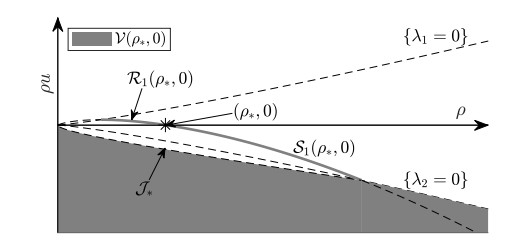









 DownLoad:
DownLoad:
